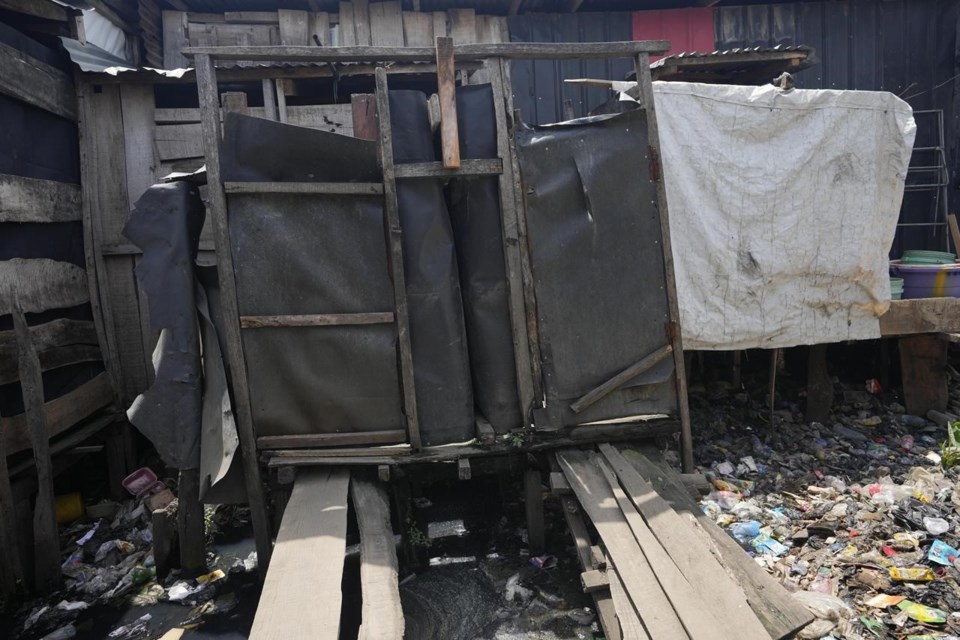LAGOS, Nigeria (AP) — When a small number of cases of locally transmitted malaria were last year, it was a reminder that climate change is reviving the threat of some diseases. But across the African continent malaria has never left, killing or sickening millions of people.
Take Funmilayo Kotun, a 66-year-old resident of Makoko, an informal neighborhood in Nigeria’s Lagos city. Its ponds of dirty water provide favorable breeding conditions for malaria-spreading mosquitoes. Kotun can’t afford insecticide-treated bed nets that cost between $7 and $21 each, much less antimalarial medications or treatment.
For World Malaria Day on Thursday, here is what you need to know about the situation in Africa:
MALARIA IS STILL WIDESPREAD
The malaria parasite mostly spreads to people via infected mosquitoes and can cause symptoms including fever, headaches and chills. It mostly affects children under 5 and pregnant women.
Vaccine efforts are still in early stages: Cameroon this year became the to routinely give children a new malaria vaccine, which is only about 30% effective and doesn't stop transmission. A was recently approved. On Thursday, WHO announced that three African countries — Benin, Liberia and Sierra Leone — were rolling out vaccine programs for millions of children.
Cases of resistance to antimalarial drugs and insecticides are increasing, while funding by governments and donors for innovation is slowing.
Living conditions play a role, with crowded neighborhoods, stagnant water, poor sanitation and lack of access to treatment and prevention materials all issues in many areas. And of mosquito previously seen mostly in India and the Persian Gulf is a new concern.
A GROWING PROBLEM
Globally, malaria cases are on the rise. Infections increased from 233 million in 2019 to 249 million in 85 countries in 2022. Malaria deaths rose from 576,000 in 2019 to 608,000 in 2022, according to the World Health Organization.
Of the 12 countries that carry about 70% of the global burden of malaria, 11 are in Africa and the other is India. Children under 5 constituted 80% of the 580,000 malaria deaths recorded in Africa in 2022.
COVID-19 HURT PROGRESS
The fight against malaria saw some progress in areas such as rapid diagnostic tests, vaccines and new bed nets meant to counter insecticide resistance, but the COVID-19 pandemic and a shift in focus and funding set back efforts.
A study published in Tropical Medicine and Infectious Disease last year said COVID-19-induced lockdowns led to disruptions at 30% of rural community health service points across Africa. Malaria cases started spiking again, breaking a downward trend between 2000 and 2019.
That downward trend could soon return, according to the WHO.
A WARMING WORLD AND NEW FRONTIERS
Africa is “at the sharp end of climate change,” and the increasing frequency of extreme weather events causes havoc in efforts to combat malaria in low- and middle-income regions, Peter Sands, the executive director of the Global Fund to Fight AIDS, Tuberculosis and Malaria, warned in December.
In 2023, the WHO's World Malaria Report included a chapter on the link between malaria and climate change for the first time, highlighting its significance as a potential risk multiplier. Scientists worry that people living in areas once inhospitable to mosquitoes, including the slopes of Mt. Kilimanjaro and the mountains of eastern Ethiopia, could be exposed.
In Zimbabwe, which has recorded some of its hottest days in decades, malaria transmission periods have extended in some districts, "and this shift has been attributed to climate change,” said Dr. Precious Andifasi, a WHO technical officer for malaria in Zimbabwe.
___
Mutsaka reported from Harare, Zimbabwe.
___
The Associated Press receives financial support for global health and development coverage in Africa from the Bill & Melinda Gates Foundation Trust. The AP is solely responsible for all content. Find AP’s for working with philanthropies, a list of supporters and funded coverage areas at .
Dan Ikpoyi And Farai Mutsaka, The Associated Press




